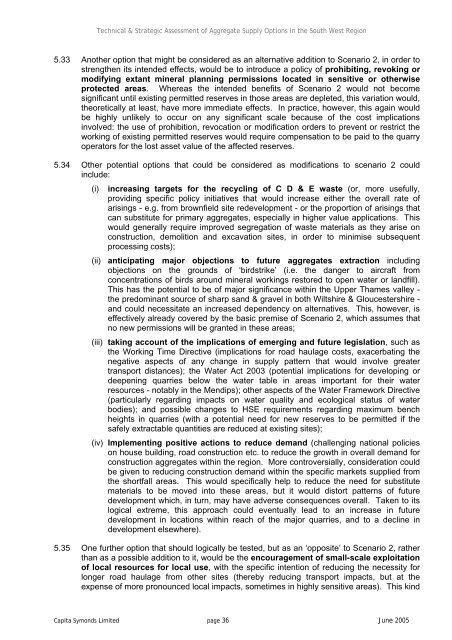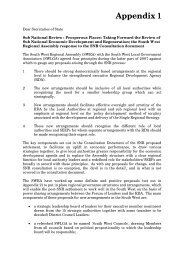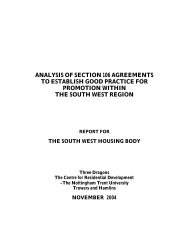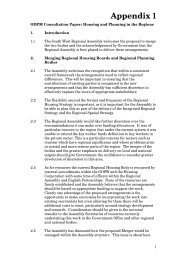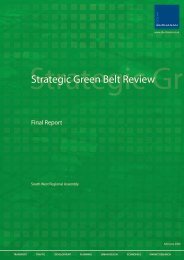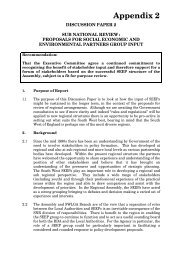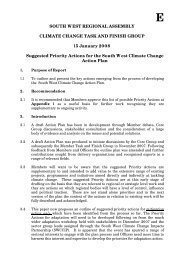Technical and Strategic Assessment of Aggregate Supply Options in ...
Technical and Strategic Assessment of Aggregate Supply Options in ...
Technical and Strategic Assessment of Aggregate Supply Options in ...
You also want an ePaper? Increase the reach of your titles
YUMPU automatically turns print PDFs into web optimized ePapers that Google loves.
<strong>Technical</strong> & <strong>Strategic</strong> <strong>Assessment</strong> <strong>of</strong> <strong>Aggregate</strong> <strong>Supply</strong> <strong>Options</strong> <strong>in</strong> the South West Region5.33 Another option that might be considered as an alternative addition to Scenario 2, <strong>in</strong> order tostrengthen its <strong>in</strong>tended effects, would be to <strong>in</strong>troduce a policy <strong>of</strong> prohibit<strong>in</strong>g, revok<strong>in</strong>g ormodify<strong>in</strong>g extant m<strong>in</strong>eral plann<strong>in</strong>g permissions located <strong>in</strong> sensitive or otherwiseprotected areas. Whereas the <strong>in</strong>tended benefits <strong>of</strong> Scenario 2 would not becomesignificant until exist<strong>in</strong>g permitted reserves <strong>in</strong> those areas are depleted, this variation would,theoretically at least, have more immediate effects. In practice, however, this aga<strong>in</strong> wouldbe highly unlikely to occur on any significant scale because <strong>of</strong> the cost implications<strong>in</strong>volved: the use <strong>of</strong> prohibition, revocation or modification orders to prevent or restrict thework<strong>in</strong>g <strong>of</strong> exist<strong>in</strong>g permitted reserves would require compensation to be paid to the quarryoperators for the lost asset value <strong>of</strong> the affected reserves.5.34 Other potential options that could be considered as modifications to scenario 2 could<strong>in</strong>clude:(i) <strong>in</strong>creas<strong>in</strong>g targets for the recycl<strong>in</strong>g <strong>of</strong> C D & E waste (or, more usefully,provid<strong>in</strong>g specific policy <strong>in</strong>itiatives that would <strong>in</strong>crease either the overall rate <strong>of</strong>aris<strong>in</strong>gs - e.g. from brownfield site redevelopment - or the proportion <strong>of</strong> aris<strong>in</strong>gs thatcan substitute for primary aggregates, especially <strong>in</strong> higher value applications. Thiswould generally require improved segregation <strong>of</strong> waste materials as they arise onconstruction, demolition <strong>and</strong> excavation sites, <strong>in</strong> order to m<strong>in</strong>imise subsequentprocess<strong>in</strong>g costs);(ii) anticipat<strong>in</strong>g major objections to future aggregates extraction <strong>in</strong>clud<strong>in</strong>gobjections on the grounds <strong>of</strong> ‘birdstrike’ (i.e. the danger to aircraft fromconcentrations <strong>of</strong> birds around m<strong>in</strong>eral work<strong>in</strong>gs restored to open water or l<strong>and</strong>fill).This has the potential to be <strong>of</strong> major significance with<strong>in</strong> the Upper Thames valley -the predom<strong>in</strong>ant source <strong>of</strong> sharp s<strong>and</strong> & gravel <strong>in</strong> both Wiltshire & Gloucestershire -<strong>and</strong> could necessitate an <strong>in</strong>creased dependency on alternatives. This, however, iseffectively already covered by the basic premise <strong>of</strong> Scenario 2, which assumes thatno new permissions will be granted <strong>in</strong> these areas;(iii) tak<strong>in</strong>g account <strong>of</strong> the implications <strong>of</strong> emerg<strong>in</strong>g <strong>and</strong> future legislation, such asthe Work<strong>in</strong>g Time Directive (implications for road haulage costs, exacerbat<strong>in</strong>g thenegative aspects <strong>of</strong> any change <strong>in</strong> supply pattern that would <strong>in</strong>volve greatertransport distances); the Water Act 2003 (potential implications for develop<strong>in</strong>g ordeepen<strong>in</strong>g quarries below the water table <strong>in</strong> areas important for their waterresources - notably <strong>in</strong> the Mendips); other aspects <strong>of</strong> the Water Framework Directive(particularly regard<strong>in</strong>g impacts on water quality <strong>and</strong> ecological status <strong>of</strong> waterbodies); <strong>and</strong> possible changes to HSE requirements regard<strong>in</strong>g maximum benchheights <strong>in</strong> quarries (with a potential need for new reserves to be permitted if thesafely extractable quantities are reduced at exist<strong>in</strong>g sites);(iv) Implement<strong>in</strong>g positive actions to reduce dem<strong>and</strong> (challeng<strong>in</strong>g national policieson house build<strong>in</strong>g, road construction etc. to reduce the growth <strong>in</strong> overall dem<strong>and</strong> forconstruction aggregates with<strong>in</strong> the region. More controversially, consideration couldbe given to reduc<strong>in</strong>g construction dem<strong>and</strong> with<strong>in</strong> the specific markets supplied fromthe shortfall areas. This would specifically help to reduce the need for substitutematerials to be moved <strong>in</strong>to these areas, but it would distort patterns <strong>of</strong> futuredevelopment which, <strong>in</strong> turn, may have adverse consequences overall. Taken to itslogical extreme, this approach could eventually lead to an <strong>in</strong>crease <strong>in</strong> futuredevelopment <strong>in</strong> locations with<strong>in</strong> reach <strong>of</strong> the major quarries, <strong>and</strong> to a decl<strong>in</strong>e <strong>in</strong>development elsewhere).5.35 One further option that should logically be tested, but as an ‘opposite’ to Scenario 2, ratherthan as a possible addition to it, would be the encouragement <strong>of</strong> small-scale exploitation<strong>of</strong> local resources for local use, with the specific <strong>in</strong>tention <strong>of</strong> reduc<strong>in</strong>g the necessity forlonger road haulage from other sites (thereby reduc<strong>in</strong>g transport impacts, but at theexpense <strong>of</strong> more pronounced local impacts, sometimes <strong>in</strong> highly sensitive areas). This k<strong>in</strong>dCapita Symonds Limited page 36 June 2005


